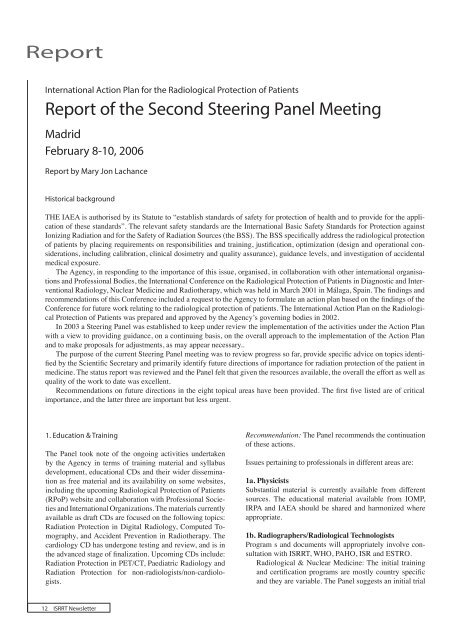ISRRT_August_2006
You also want an ePaper? Increase the reach of your titles
YUMPU automatically turns print PDFs into web optimized ePapers that Google loves.
Report<br />
International Action Plan for the Radiological Protection of Patients<br />
Report of the Second Steering Panel Meeting<br />
Madrid<br />
February 8-10, <strong>2006</strong><br />
Report by Mary Jon Lachance<br />
Historical background<br />
THE IAEA is authorised by its Statute to “establish standards of safety for protection of health and to provide for the application<br />
of these standards”. The relevant safety standards are the International Basic Safety Standards for Protection against<br />
Ionizing Radiation and for the Safety of Radiation Sources (the BSS). The BSS specifically address the radiological protection<br />
of patients by placing requirements on responsibilities and training, justification, optimization (design and operational considerations,<br />
including calibration, clinical dosimetry and quality assurance), guidance levels, and investigation of accidental<br />
medical exposure.<br />
The Agency, in responding to the importance of this issue, organised, in collaboration with other international organisations<br />
and Professional Bodies, the International Conference on the Radiological Protection of Patients in Diagnostic and Interventional<br />
Radiology, Nuclear Medicine and Radiotherapy, which was held in March 2001 in Málaga, Spain. The findings and<br />
recommendations of this Conference included a request to the Agency to formulate an action plan based on the findings of the<br />
Conference for future work relating to the radiological protection of patients. The International Action Plan on the Radiological<br />
Protection of Patients was prepared and approved by the Agency’s governing bodies in 2002.<br />
In 2003 a Steering Panel was established to keep under review the implementation of the activities under the Action Plan<br />
with a view to providing guidance, on a continuing basis, on the overall approach to the implementation of the Action Plan<br />
and to make proposals for adjustments, as may appear necessary..<br />
The purpose of the current Steering Panel meeting was to review progress so far, provide specific advice on topics identified<br />
by the Scientific Secretary and primarily identify future directions of importance for radiation protection of the patient in<br />
medicine. The status report was reviewed and the Panel felt that given the resources available, the overall the effort as well as<br />
quality of the work to date was excellent.<br />
Recommendations on future directions in the eight topical areas have been provided. The first five listed are of critical<br />
importance, and the latter three are important but less urgent.<br />
1. Education & Training<br />
The Panel took note of the ongoing activities undertaken<br />
by the Agency in terms of training material and syllabus<br />
development, educational CDs and their wider dissemination<br />
as free material and its availability on some websites,<br />
including the upcoming Radiological Protection of Patients<br />
(RPoP) website and collaboration with Professional Societies<br />
and International Organizations. The materials currently<br />
available as draft CDs are focused on the following topics:<br />
Radiation Protection in Digital Radiology, Computed Tomography,<br />
and Accident Prevention in Radiotherapy. The<br />
cardiology CD has undergone testing and review, and is in<br />
the advanced stage of finalization. Upcoming CDs include:<br />
Radiation Protection in PET/CT, Paediatric Radiology and<br />
Radiation Protection for non-radiologists/non-cardiologists.<br />
Recommendation: The Panel recommends the continuation<br />
of these actions.<br />
Issues pertaining to professionals in different areas are:<br />
1a. Physicists<br />
Substantial material is currently available from different<br />
sources. The educational material available from IOMP,<br />
IRPA and IAEA should be shared and harmonized where<br />
appropriate.<br />
1b. Radiographers/Radiological Technologists<br />
Program s and documents will appropriately involve consultation<br />
with <strong>ISRRT</strong>, WHO, PAHO, ISR and ESTRO.<br />
Radiological & Nuclear Medicine: The initial training<br />
and certification programs are mostly country specific<br />
and they are variable. The Panel suggests an initial trial<br />
12 <strong>ISRRT</strong> Newsletter


















